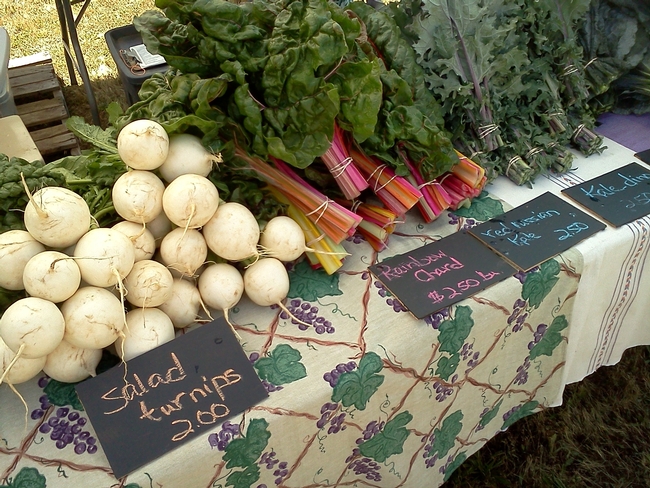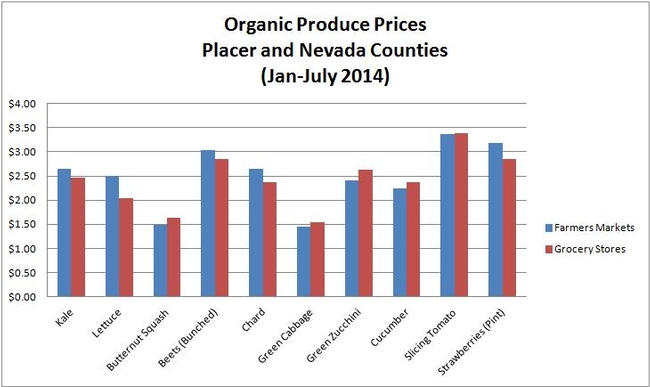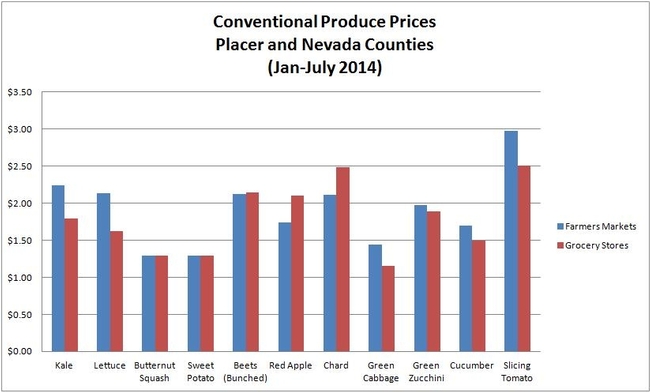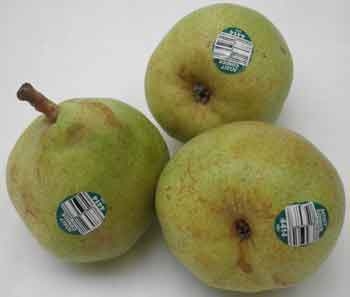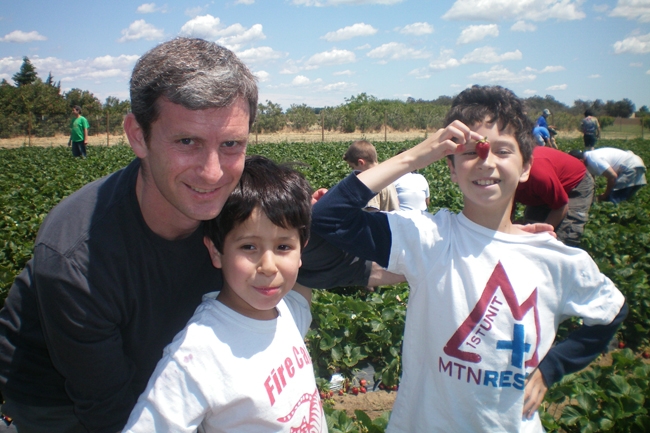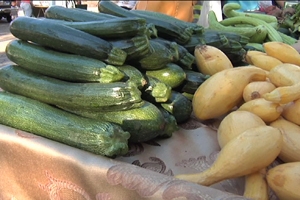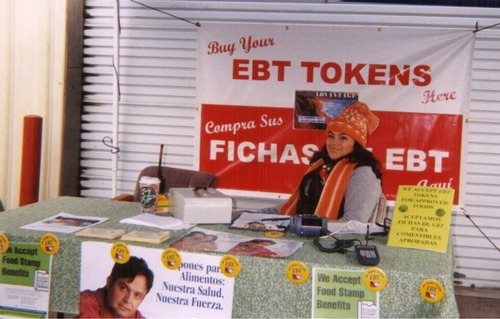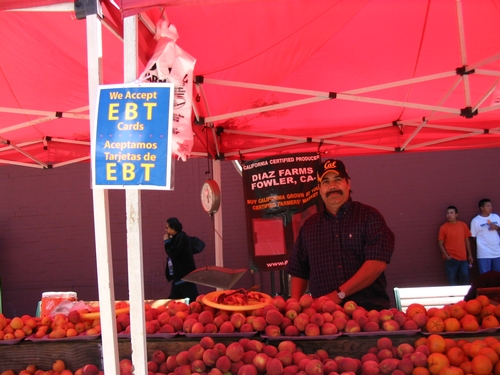Posts Tagged: Farmers markets
Farmers market prices compare well with the supermarket produce aisle
Many shoppers believe they can buy cheaper produce at supermarkets than at local farmers markets. A new UC Cooperative Extension study dispels that common misperception.
In Placer and Nevada counties, UCCE received a CDFA Specialty Block Grant to encourage consumers to eat more fruits and vegetables and support the local agricultural industry by buying the produce from them. The project led to the creation of the “Eat Local Placer Nevada” campaign.
“Buying locally grown products supports local farmers and ranchers and it keeps land in agriculture,” said Cindy Fake, UCCE farm advisor in Placer and Nevada counties. “Simply put, it's the right thing to do.”
To give consumers extra incentive to eat local, the group launched a seven-month study to compare prices at farmers markets and grocery stores. Volunteers and staff collected price data at four farmers markets and six grocery stores from January to July 2014. Specials and sale items were not part of the study. The data suggests that organic produce at farmers markets is priced about the same as organic produce at grocery stores.
In terms of conventional produce, grocery stores had cheaper prices on 6 out of 11 items; however, consumers would still save money picking up red apples, beets and chard at the farmers markets. The cost of conventional butternut squash and sweet potatoes was virtually equal at the two venues.
“Contrary to many consumers' perception, farmers market prices are competitive with regular supermarket prices,” Fake said. “Some prices are slightly higher, some slightly lower, but they are in the same range. “
However, there are other factors shoppers should keep in mind when deciding to buy supermarket produce or fruit and vegetables grown by their neighboring farmers.
“Produce at the farmers market is sold the same day or the day after it is harvested,” Fake said. “Because of that, its shelf life is two to three times longer than what is found in the supermarket. And because it is so fresh, you have a higher nutrient content and it will taste better.”
Fake said experts believe buying local also supports the local economy. She is collaborating on a project led by Shermain Hardesty, UCCE specialist in the Department of Agricultural and Resource Economics at UC Davis, to document the economic impact of local food systems in Placer, El Dorado, Sacramento and Yolo counties. The researchers will gather data about farmers' purchases of inputs and local sales of produce.
“This project will provide science-based evidence to guide public policy and program design aimed at supporting local farmers and local food systems into the future,” Fake said.
The study – titled Measuring the Impact of Local Food Marketing on the Local Economy – is supported with a $226,048 grant from the UC Division of Agriculture and Natural Resources.
California's delicious harvest season unfolds
Early spring can be an invigorating time of year, with lengthening days, blooming daffodils and fruit trees (and ski season still in full force). One of the best perks of the season is the availability of luscious strawberries, and tasty artichokes and asparagus picked from nearby farms, with flavor quality and price that reflects both in-season and local transportation benefits.
Depending on your location, farmers markets and pick-your-own farms will begin offering their wares within the next month or two. There are over 700 farmers markets in California. A wide variety of produce, from the exotic to the humble every-day variety, is available to entice you with its fresh beauty. We here in the West spend more annually on fresh produce at $511 vs. the national average of $429, wrote Roberta Cook, UC Cooperative Extension specialist in the UC Davis Department of Agriculture and Resource Economics, in “Eye on Economics: Much more than Dollars and Cents. Cook states that, “California produces half of the nation’s fresh fruits and vegetables and consumers here are privileged to have an abundance of high quality fresh produce over extended seasons due to California’s Mediterranean climate.”
Elsewhere in the United States “local” food markets are much less developed due to climate restrictions that limit production to a brief period in the summer and early fall; and the variety of products grown is only a fraction of the over 200 crops grown in California. While “local” production represents a rapidly growing share of U.S. agricultural sales, with direct-to-consumer sales more than quadrupling in the past decade, outside of California the share is still tiny.
There are few things as disappointing as biting into a piece of fruit that looks beautiful on the outside but just doesn’t deliver that burst of flavor, or cutting into a nice-looking vegetable only to find an unsightly defect inside. When I’m prowling through a display of fresh produce, I rev up all my senses into high gear and get up-close and personal with the fruit and veggie items on my list. I get busy feeling the weight-to-size ratio, gently (not too hard, mind you, or you’ll get a bad reputation with other shoppers) pressing to feel for firmness, looking at color, form, and stem separation area, and smelling the aroma. All of these things, and more, help provide clues about the quality inside.
Country of Origin Labeling (COOL) and Price Look Up (PLU) stickers
Other clues are often available about where and how your produce items were grown. For instance, in 2009 rules (affecting retail grocers) were adopted by the USDA mandating country of origin labeling (COOL), which required that retailers notify customers of the country of origin of all perishable agricultural commodities. Also offering insights into your produce selection is the Price Look Up sticker. Created by the Produce Marketing Association (PMA) in 1987 to create a standardized system to assist check-out clerks with looking up the produce items, it also indicates additional information such as whether it’s organic.
For instance, if your produce item’s sticker has a 4 digit code, it is “conventionally grown, but not organic.” If the code has 5 digits, and the first digit is a 9, the produce was organically grown. Usually the PLU stickers also include the country of origin in writing, but if not, this information should be displayed on the packing box or other store signage. Conventionally grown produce is recognized by scientists and regulators to be just as safe as organically grown and there is no evidence that it is worse for the environment. About 95 percent of retail fresh produce sales are conventionally grown and generally cost about 30 percent less than organics.
There are a number of resources that can help produce shoppers improve their savvy shopping skills:
From the Farm to Your Table: A Consumer’s Guide to Fresh Fruits and Vegetables, by James Thompson and Adel Kader. This 16-page booklet offers information on measuring quality; farm-based growing conditions, practices and harvesting; handling, transportation and storage; and selecting and storing good-quality produce for use at home. The table on how to select good-quality produce is especially helpful. ($7.00/copy)
Shopping for Fruits & Vegetables at the Fruits and Veggies: More Matters web site
Storing Fresh Fruit and Vegetables for Better Taste, a free downloadable poster from the UC Davis Postharvest Technology Center
i know produce, a comprehensive produce website developed by the Produce Marketing Association (PMA) that includes photo identification, written description, availability by location, nutrition information, storage/handling, and tips.
A fruitful approach
I have two active young sons. They get plenty of exercise. Their diets, however, can be a challenge. They have different tastes – one could eat breakfast items all day; the other could eat dinner items all day. One likes sugary sweet foods; the other likes salty, fatty foods. My wife is a great cook who makes balanced, nutritious meals, but it’s not easy pleasing everybody. There is one thing we all can agree on: We love fruit.
We can eat fruit throughout the day. It might go with breakfast, with lunch, as a snack or mixed in with a salad at dinner. I think my kids like fruit not only because we make it available and encourage them to eat it, but because they have sampled fresh fruit at farmers markets, watched it grow in our backyard and harvested it themselves at U-pick farms.
The federal government’s new MyPlate nutrition guidelines emphasize fruits and vegetables – they’re half the plate. But it’s not enough to try to force-feed your children canned carrots. Food can be fun. Giving kids a hands-on experience with fresh fruit can help them appreciate its importance. I’m no dietitian, but as a parent, I offer three tips for helping children to eat more fruits (and vegetables).
- Go to a farmers market. California has more farmers markets than any other state in the country. Find one near you at www.cafarmersmarkets.com. At a farmers market, the food and the farmers are the stars. You can sample the goods. You can ask a farmer questions. You can learn about the difference between a blood orange and a Cara Cara orange. It’s an event, but a short one. And the price is moderate.
- Grow your own produce. We’ve had mixed results with this one. Tomatoes came out great one year, were poached by animals another. We have a couple of fruit trees in our yard, but they don’t get much sun and the fruit isn’t sweet. We have had success with herbs, though, and find that our sons will munch on a mint leaf or point out the plants to friends and family. On a recent visit to their aunt and uncle’s house, they picked giant lemons and enjoyed homemade lemonade. No matter how small the effort, it shows children the life cycle of a plant, the anticipation of healthy food and, hopefully, the payoff of plentiful produce for a low cost.
- Visit a U-pick farm. We get an early start to summer by visiting U-pick farms in Brentwood. One son prefers cherries; the other prefers strawberries. Between the two, we have a daylong excursion that provides a weeklong supply of delicious bite-sized fruit for a reasonable price. Brentwood’s cherry season typically lasts from May to June. You can still find peaches, strawberries and other crops there in July. We also went apple picking in September in Sonoma County. U-picking is part of the broader field of agritourism, which also can include farm stands, tours, fairs and festivals. The University of California maintains a statewide agricultural tourism directory at http://calagtour.org. Check it out and may your efforts be fruitful.
Shopping for fruits and vegetables 'like we used to'
Shopping outdoors and having the chance to freely choose, ask questions, taste, and perhaps haggle a little are some of the reasons for immigrants from Latin America and elsewhere to find farmers markets particularly appealing. Childhood memories of going to open-air markets with their families are probably another big reason for them, but also for many older U.S. born consumers who are becoming regular customers.
Fortunately, as more non-Latinos and non-immigrants discover or re-discover the advantages of buying fresh produce grown by small farmers, we all will have more opportunities to enjoy getting our favorite fruits and vegetables "like we used to."
For my wife, Sylvia, and I is a lot more fun to buy our produce at our nearby farmers markets in Redlands and San Bernardino than shopping at the supermarket in our neighborhood. Going from stall to stall checking out what's offered is a totally different experience, and certainly more exciting. Unfortunately, these markets don't operate during the winter months, so we'll have to wait until next year.
We feel that we get more for our money at farmers markets. Eager to sell, vendors gladly greet you and talk to you as if you weren't a stranger to them. You feel invited to take a closer look at what they're selling. They try to show you that they care about you as an individual customer and want you to be happy with your purchase, just like it used to be before big supermarkets took over our food supply.
Not yet convinced? How about taking a bite of the fruit or vegetables that many vendors have always ready for you to sample? When was the last time they treated you like that at your local supermarket?
For my wife and I, that's the closest thing to going back in time when we went shopping at the produce markets of our childhoods, hers in Nicaragua, and mine in México. It's a tradition that can be traced to the Aztec's tianguis, as those ancient Mexicans called their open-air marketplaces.
Spanish conquerors were marveled at the wide and colorful array of fresh fruits, vegetables, and herbs sold at the indigenous marketplaces, as described by Bernardino de Sahagún in his Historia general de las cosas de la Nueva España (General History of the Things of New Spain). They found elotl (fresh corn) and teosintl (dry corn for tortillas and tamales), éxotl (green beans, also sold as dry beans) tomatl, (tomatos) ayotl (offered as zucchini and pumpkin), aguacatl (avocado), an enormous variety of chiles (peppers), and many other foods native to pre-colonial Latin America that now help to feed the world.
With the help of UCANR's Small Farm Program and its farm advisors, California growers continue to provide us with an ever-increasing variety of fruits and vegetables that are dear to the heart of immigrants from all corners of the world. Many of these can be found at farmers markets close to you.
Granted, the produce at open-air markets may not look as gorgeously tempting as the fruits and vegetables carefully polished and arranged at grocery stores. But my wife and other farmer market regulars swear by the flavor of the goods they get from these modern day nomadic food merchants.
You may have to pay a little more than at chain supermarkets that buy huge quantities of produce at very low prices from giant farms, which may be thousands of miles away or in other countries. But by purchasing at local farmers markets we get the feeling that we are helping to keep our state's agricultural tradition alive.
Buying produce grown at local farms is definitely a way to contribute to your own community. More than often, there's no question about who wins by shopping from these markets.
At a recent visit to the downtown San Bernardino farmers market my wife intended to buy only a few serrano peppers. After paying for them, she was surprised when the vendor gave her a full bag, more than two pounds of peppers!
"What would I do with all that?" she later told me. She took it home anyway and found a recipe to make Chiles encurtidos (pickled peppers). Next time you're this lucky, look for one of the many recipes for preserving fruits and vegetables on the Internet, and tips to preserve produce at home, including a short video with the do's and don'ts to prevent food poisoning.
Like most industries, farmers markets are well aware of demographics and are usually staffed by Spanish-speaking vendors; knowledgeable of Latino immigrants' customs, it's not uncommon for them, as they hand you the goodies that you've bought, to put an extra fruit or vegetable in the bag or in your hand as a token of appreciation.
"This one's for you," they'd say with wink and a smile.
Have you gotten one of those treats lately at your local supermarket?
Shoppers at the Redlands farmers market.
Farmers markets welcome food stamp shoppers
Don't take any wooden nickels? When the new Oak Park Farmers' Market in Sacramento opened last month, organizers made sure to have wooden tokens ready for opening day. Farmers' selling at farmers' markets and flea markets all over California will gladly accept wooden nickels, plastic tokens, or paper "market dollars" this summer in exchange for good food.
The Stockton Farmers Market under the crosstown freeway is wide awake at 7 every Saturday morning all year round, crowded with farmers and shoppers conducting a brisk business in fresh local fruits and vegetables, fish, eggs, tofu, flowers and lots more, often talking four or five different languages but managing just fine to communicate with each other. Every Saturday, thousands of dollars of sales are transacted using bright green plastic tokens. The tokens are part of a program by farmers' markets throughout California to ensure that the markets are accessible to all Californians.
Paper food stamps haven't existed in California since 2004, but many people still use the old name, food stamp program, when they talk about what is now the Supplemental Nutrition Assistance Program (SNAP). As a result of high unemployment and hard times, one in eight Americans receives SNAP benefits to purchase food. SNAP benefits are now issued electronically, and SNAP recipients shop using electronic benefits transfer (EBT) cards, which work like debit cards.
Farmers market vendors usually don't have the electricity, phone lines and authorization from the USDA needed to accept EBT cards as payment, so farmers market managers need to set up scrip systems for customers to use the cards. A market staff person swipes the card using a state-issued wireless terminal and sells the customer tokens to shop with. At the end of the market day, market vendors exchange any tokens received that day for cash from the market staff.
This year, help is available to market managers and associations implementing and promoting EBT access at their markets and welcoming SNAP customers:
- First, markets need to apply to be a SNAP retailer
- The California Department of Social Services will provide a free wireless terminal to any California market authorized by USDA to operate an EBT/scrip system. Contact Dianne Padilla-Bates, (916) 654-1396, dianne.padilla-bates@dss.ca.gov
- The Ecology Center Farmers' Market EBT Project, partially funded by the California Department of Food and Agriculture, will help market managers and associations with free consultation, free tokens, with setting up staffing, accounting, vendor training and with building community partnerships and designing custom posters and flyers to promote the markets to SNAP customers.
- To encourage more markets to open their stalls to SNAP customers, the USDA has just released its own How-to Handbook for accepting EBT at farmers' markets


